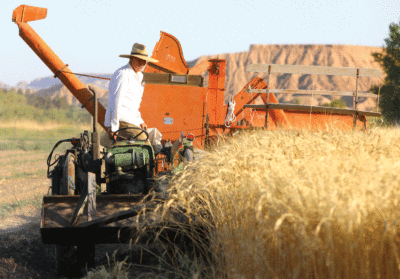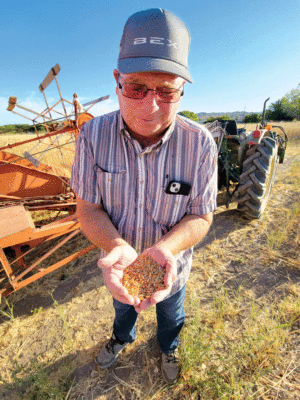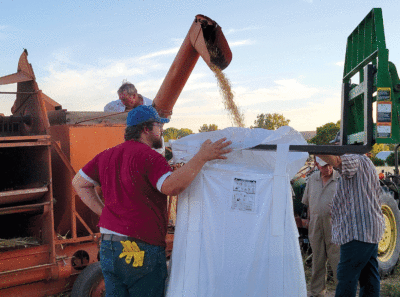By VERNON ROBISON
The Progress

A group of Moapa Valley farmers worked hard last weekend to bring in a rather uncommon crop for this desert southwest community. Using 1950s era equipment they harvested three acres of kamut wheat.
The field located just south of State Highway 169 in Logandale was planted last November. It was a cooperative effort between local brother/farmer team Jim and Stan Hardy and Laura and Monte Bledsoe of Quail Hollow Farms.
Dennis and Sandra Barrett own the field which they lease to the Hardys. It is usually cultivated in hay. But last fall, the Hardys and the Bledsoes got to talking and made some plans to do something different.
Stan Hardy admitted that the past couple of years have been a bit unsettling to him as a farmer. With the pandemic, followed immediately by various supply chain crises, he has found himself worrying about the possible disruption in a reliable and sufficient source of food for his community.

“I don’t think there ever will be an actual shortage of food, but there could very well be a shortage of the pipeline distributing the food,” Stan Hardy said. “I mean, farmers are going to grow the food. But is it going to get processed and get put in Walmart so we can all buy it? There are possible problems there.”
So that got Stan thinking about what would be needed to begin to grow staple food crops once again in the Moapa Valley.
“In the old days, that used to be done all the time,” Stan said. “But it takes a little know-how on what to do. And you want to have the right equipment lined up and operating.”
Last year, Stan and Jim decided they wanted to try growing wheat because of its important role as a staple food crop.
“We just wanted to grow a little bit to re-acquaint ourself with what we could do and what we needed to do,” Stan said.
Perhaps the biggest problem in growing wheat in a small farming operation is the harvesting and separating the small grains from all the chaff. Nowadays, that kind of work is done on a huge scale with very large and expensive machinery. Manufacturers no longer make smaller machines used for harvesting just a couple of acres at a time..
Monte and Laura Bledsoe ran into that problem several years ago. They tried to plant a small amount of wheat that they planned to harvest with old fashioned hand tools. They found it was a very laborious process.
“We tried using scythe and sickle to harvest it,” Laura said. “And of course, you have to do it in June when it is pretty darn hot. We made the sheaves and tried to winnow it. And I have to tell you, we got disenchanted pretty fast. We realized that if the only way to do it was to do it all by hand, we would all eat far less bread!”

Not willing to give up on the idea, the Bledsoes began an extensive search for an old combine, a piece of equipment which both cuts and winnows the wheat – separating the grain from the straw.
To find a combine small enough to fit in their budget and in their scope of work, they knew it would have to be a fairly historic piece of equipment; something from back in the day of smaller family farm operations.
Their search actually turned up two combines. They were both 1956 Allis Chalmers All-Crop Harvesters located in Iowa of all places. The Bledsoes quickly bought them both for a total of $600.
“We were so excited until we realized that we had to figure out how to get them home,” Laura said. “That was a fun adventure.”
When the couple finally got the two machines home, Monte went to work on them. Using one of the units for parts, he was able to cobble together one operating combine.
They successfully used that equipment to harvest an acre of wheat that they had raised in an Overton field. The Progress reported on that harvest in June of 2015.
Stan Hardy recalled that harvest last year when he was making plans to grow wheat in the Barretts’ field. He contacted the Bledsoes and asked if they wanted to work together on a larger wheat crop. The Bledsoes enthusiastically accepted.
They used a unique type of wheat that the Bledsoes had planted before. It is an ancient grain variety called Khorasan wheat.
“It is a fabulous wheat to grow here because it can handle the heat and it does best not being overly wet,” Laura Bledsoe said. “It has only been irrigated three or four times since it was planted in November.”
There are also health benefits to this wheat. Having had no genetic engineering done to it, Khorasan carries a significantly lower amount of gluten in the kernel. That means it is better for those who are intolerant to gluten, Laura said.
On Friday evening last week, a small crowd of curious onlookers gathered on the north end of the Barrett’s field as Monte Bledsoe fired up the old combine and made the first pass around the field.
It was slow going. Monte took his time cutting through the thick growth, stopping to make small mechanical adjustments as he went. He had to stop several times just to clear out the machine when it got bound up with chaff and straw. But it continued working well into the evening.
The following morning Monte was back and at it again. It took several sessions of dusty, hot work to complete the harvest.
In the end, the three acre field was expected to harvest around five tons of wheat. Both the Hardys and the Bledsoes were pleased with the yield.
“Let’s face it, we aren’t looking to make big bucks off of this type of thing,” Stan Hardy said. “In fact, it is kind of a pain and we do better to stay with alfalfa because we have all the equipment and we do it all the time. But we felt like we needed to refresh ourselves on the ability to grow food with the right timing and make sure everything works. It shows we can do it.”
The Hardys plan to sell some of the wheat to the public in the fall along with their usual farm stand of melons, pumpkins and corn. The Bledsoes are planning to have wheat on sale at their Quail Hollow Farm Stand as soon as possible.
Laura Bledsoe said that it has been her dream to involve members of the community in developing recipes and techniques for the best use of this home-grown wheat.
“We have some amazing bakers out there in this community,” Laura said. “I would love to have a group that wants to get together and learn how to really make the most out of this wheat; whether it be pasta or bread or other baked goods.”
“This ancient grain can really be used in practically anything you would use wheat for,” Laura added. “We just need to fine tune the technique a bit for bread because of the gluten situation. But I have to say, it does make a tasty loaf of bread!”
Those wishing to be involved in this project can contact Laura by email at quailhollowfarm@mvdsl.com. Or come by the Quail Hollow Farm stand at 1395 N Andersen Street in Overton.








![ElectionAd [Recovered]2](https://mvprogress.com/wp-content/uploads/2024/05/4-24-2024-FC-ElectionAd-Finalv3.jpg)

